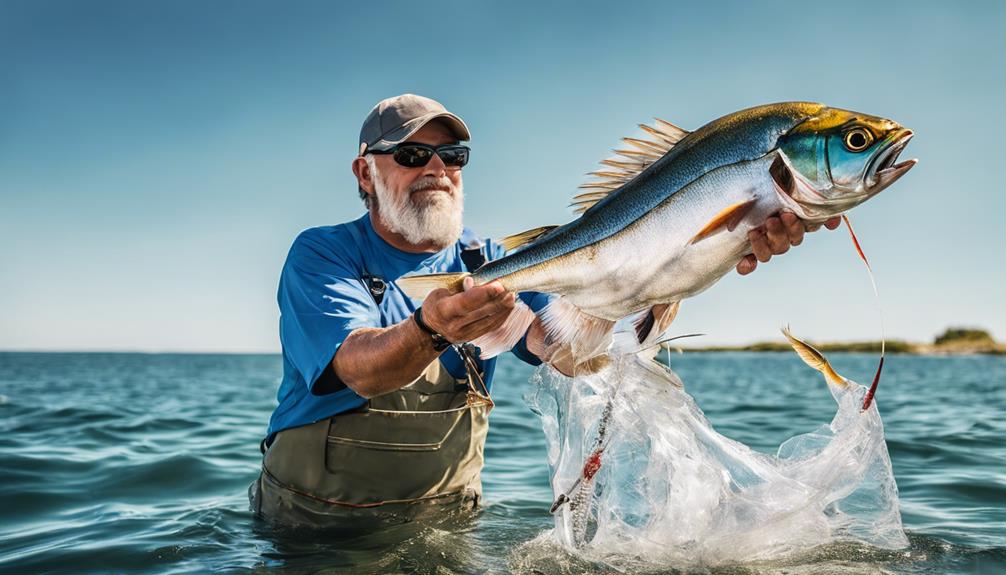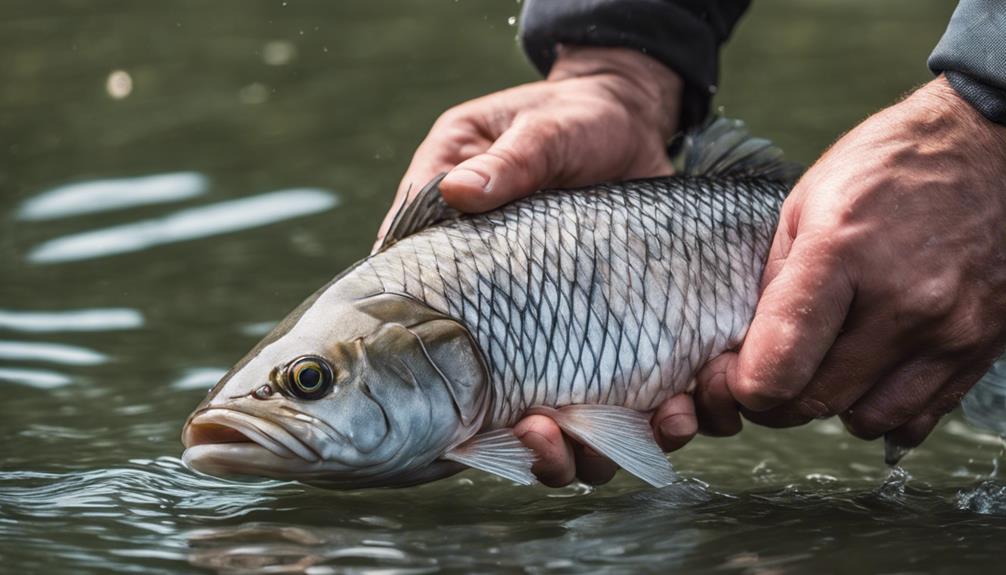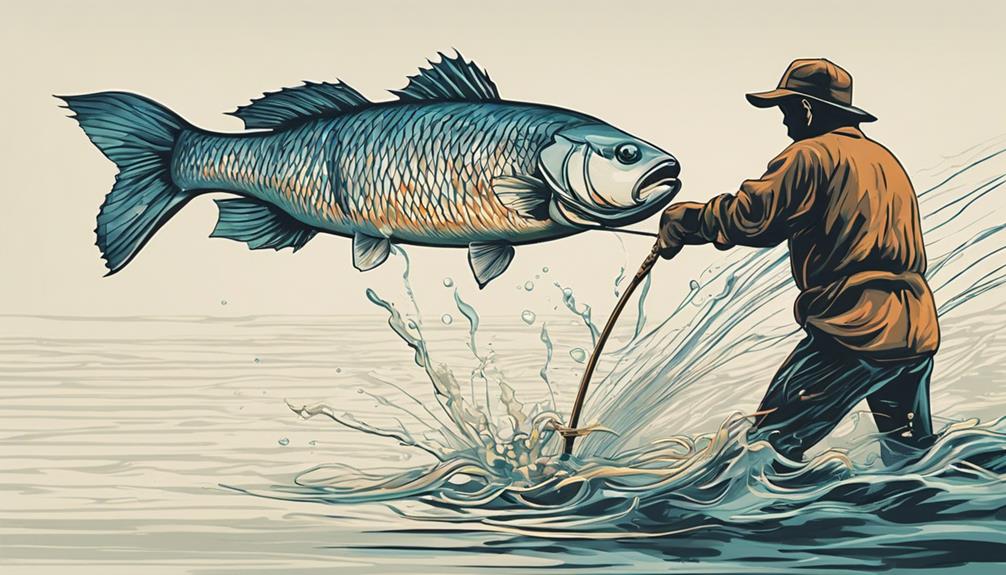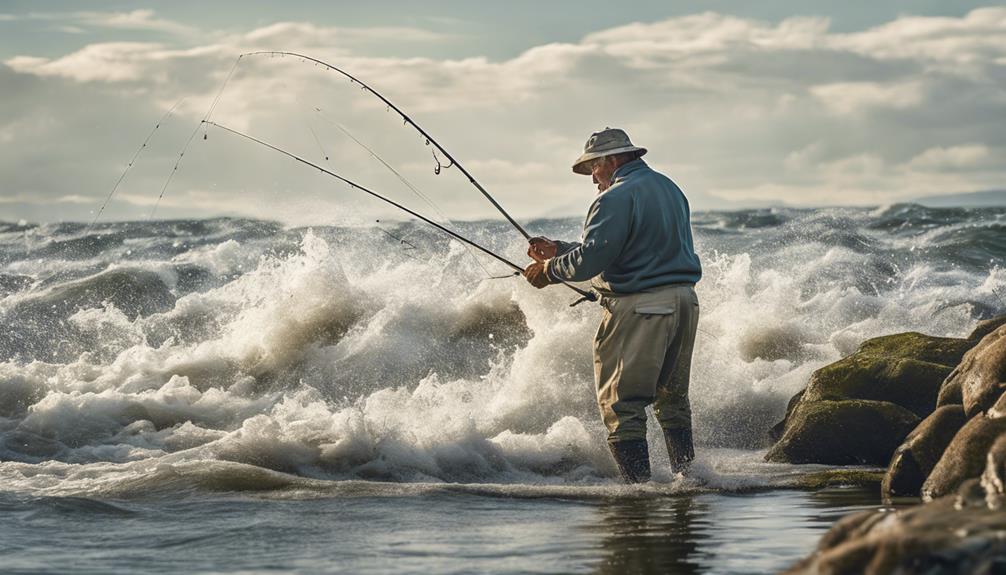Imagine you've just hooked a beautiful rainbow trout on your latest fishing excursion. As you reel it in, you realize the importance of perfecting your catch and release skills.
But do you know the proper techniques to ensure the fish's survival once you release it back into the water? Mastering these skills not only enhances your fishing experience but also contributes to the sustainability of fish populations.
Want to discover the key strategies for successful catch and release?
Importance of Catch and Release

Catch and release fishing is crucial for preserving fish populations and ensuring sustainable angling practices. By releasing fish back into the water unharmed, anglers like yourself can enjoy the sport while also benefiting the environment. One of the key benefits of catch and release fishing is its contribution to conservation awareness. As you practice catch and release, you become more aware of the importance of maintaining healthy fish populations in our waters.
Engaging in catch and release fishing provides numerous benefits, not only for the fish but also for the ecosystem as a whole. By releasing fish back into their natural habitat, you're giving them the opportunity to continue breeding and contributing to the population growth. This practice helps in maintaining a balanced ecosystem and prevents overfishing, which can have detrimental effects on aquatic life.
Moreover, catch and release fishing promotes conservation awareness among anglers. As you release fish back into the water, you're actively participating in the preservation of fish populations for future generations. This hands-on experience fosters a sense of responsibility towards the environment and encourages sustainable angling practices. By understanding the importance of catch and release, you're contributing to the conservation of our precious aquatic resources.
Proper Handling Techniques
Utilize gentle and precise movements when handling fish to minimize stress and ensure their safe release back into the water. Proper handling techniques are crucial for fish safety and the success of catch and release fishing. Here are some handling tips to help you master this skill:
- Wet Hands: Always wet your hands before handling a fish to avoid removing their protective slime coat, which can make them more susceptible to infections.
- Support the Fish: When lifting a fish, support its weight properly with both hands to prevent excessive pressure on its internal organs.
- Avoid Contact with Gills: Refrain from touching the gills as they're delicate and essential for the fish's breathing.
- Use Barless Hooks: Opt for barbless hooks to make hook removal easier and less harmful to the fish.
- Minimize Air Exposure: Limit the time the fish spends out of the water to reduce stress and prevent exhaustion.
Following these handling tips ensures that the fish remains healthy and unharmed during the catch and release process. By treating the fish with care and respect, you contribute to preserving the aquatic ecosystem and maintaining sustainable fishing practices. Mastering proper handling techniques not only benefits the fish but also enhances your overall fishing experience.
Selecting the Right Equipment
To ensure successful catch and release fishing, selecting the right equipment is essential for maximizing your chances of a safe and efficient fishing experience. Proper gear selection plays a crucial role in the effectiveness of your catch and release efforts. It's important to maintain your equipment regularly to ensure its functionality when you need it most. Inspect your gear for any signs of wear and tear, focusing on your fishing rod, reel, and tackle box. Ensuring your equipment is in top condition will help prevent any unexpected malfunctions during your fishing trips.
When it comes to selecting the right equipment for catch and release fishing, choosing proper bait and fishing line is key. Select bait that's easy for fish to spot and strike but doesn't harm them during the hooking process. Artificial lures can be a good choice as they're often easier to remove from a fish's mouth compared to live bait. Additionally, using barbless hooks can make the hook removal process smoother and less damaging to the fish.
Maintaining your equipment and selecting the right gear, bait, and fishing line are essential steps in improving your catch and release fishing skills. By paying attention to these details, you can enhance your fishing experience while also ensuring the safety and well-being of the fish you catch.
Best Practices for Hooks
Selecting the right hooks is crucial for successful catch and release fishing, ensuring minimal harm to the fish and maximizing your chances of a safe and efficient release. When considering hook selection, it's essential to prioritize ethical practices to promote the well-being of the fish population. Opting for barbless hooks is a key component in reducing harm and facilitating an easier release process.
- Choose the Right Size: Select a hook size that matches the type of fish you're targeting. Using too large or too small of a hook can lead to increased injury or poor hook sets.
- Opt for Barbless Hooks: Barbless hooks are easier to remove, causing less damage to the fish and increasing their chances of survival post-release.
- Quality Matters: Invest in high-quality hooks that are less likely to bend or break during the fight, reducing the risk of leaving parts of the hook in the fish.
- Mind the Gap: Ensure the gap between the point and shank of the hook is appropriate for the type of bait you're using, improving hook sets and minimizing deep hooking.
- Proper Hook Removal: Practice safe and efficient hook removal techniques to minimize handling time and stress on the fish, increasing their chances of a successful release.
Time and Conditions for Release
Considering the optimal time and conditions for releasing a fish back into its habitat is crucial for promoting its survival and well-being after the catch. To ensure the ideal release of a fish, it's essential to release it as quickly as possible after the hook is removed. Lingering too long before releasing the fish can increase its stress levels and reduce its chances of survival. The optimal timing for release varies depending on factors such as water temperature, fish species, and the fight time it endured during the capture.
When releasing a fish, it's best to do so in calm waters away from strong currents or predators. This will give the fish a better chance to recover and swim away safely. Additionally, releasing the fish in an area with suitable habitat, such as vegetation or underwater structures, can provide it with immediate protection and resources to aid its recovery post-release.
Understanding Fish Behavior
Observing fish behavior can provide valuable insights into their feeding patterns and preferred habitats. By understanding how fish behave in their natural environment, you can improve your chances of a successful catch and release.
Here are some key points to consider:
- Feeding Habits: Different fish species have varying feeding habits. Some are bottom feeders, while others prefer to feed near the surface. Understanding what your target species eats can help you choose the right bait or lure.
- Territorial Behavior: Fish can exhibit territorial behavior, especially during spawning seasons. Knowing where certain fish establish their territories can increase your chances of finding them.
- Activity Levels: Fish are more active during certain times of the day. Observing their behavior can help you determine the best times to fish.
- Response to Weather: Fish behavior can be influenced by weather conditions. Understanding how they react to changes in weather can help you adapt your fishing techniques accordingly.
- Habitat Preferences: Different fish species prefer specific habitats. Knowing where they like to dwell, such as rocky areas or submerged vegetation, can guide you to the right fishing spots.
Monitoring Fish Health

To ensure the sustainability of fish populations, it's essential to monitor their health regularly while engaging in catch and release fishing. Monitoring fish health is crucial to minimize fish stress and increase release success rates. When handling fish, always wet your hands before touching them to protect their delicate skin and mucus layer. Avoid squeezing the fish tightly or dropping them onto hard surfaces, as this can cause injuries and increase stress levels.
Signs of fish stress include rapid gill movement, erratic swimming behavior, and excessive mucus production. If you notice these signs in a fish you've caught, it's important to handle the fish with care and release it promptly to minimize any negative impact on its health. Properly managing fish stress contributes to higher release success, ensuring that the fish can recover and thrive after being released back into the water.
After catching a fish, take the time to observe its behavior before releasing it. If the fish appears lethargic or disoriented, gently move it back and forth in the water to help oxygenate its gills. Once the fish shows signs of readiness to swim away, release it gently and watch as it regains strength and swims off, indicating a successful release. By monitoring fish health and minimizing stress during catch and release practices, you can contribute to the preservation of fish populations and the overall health of aquatic ecosystems.
Engaging in Conservation Efforts
Engage actively in conservation efforts to protect fish populations and promote the health of aquatic ecosystems. By actively participating in conservation initiatives, you can make a meaningful impact on the environment and help preserve fish populations for future generations.
Here are some key actions you can take to contribute to the well-being of fish populations and reduce the environmental impact of fishing:
- Support Sustainable Fishing Practices: Choose to engage in sustainable fishing practices that prioritize the long-term health of fish populations and their habitats.
- Participate in Habitat Restoration Projects: Get involved in local habitat restoration projects to help improve the quality of aquatic environments and create better living conditions for fish.
- Advocate for Marine Protected Areas: Support the establishment of marine protected areas to safeguard critical habitats and allow fish populations to thrive without human interference.
- Educate Others About Conservation: Spread awareness about the importance of conservation efforts and encourage others to adopt practices that benefit fish populations and the environment.
- Reduce Pollution and Plastic Waste: Minimize your environmental impact by properly disposing of fishing gear, reducing plastic waste, and preventing pollution that can harm fish and their habitats.
Frequently Asked Questions
Can Catch and Release Fishing Have a Negative Impact on Fish Populations?
Catch and release fishing can have a negative impact on fish populations if not done properly. Fish behavior can be affected by stress from being caught and released.
Environmental factors, like habitat health, play a role in the survival of released fish. It's important to handle fish gently, minimize their time out of water, and release them in suitable conditions to increase their chances of survival and maintain fish populations.
How Can Anglers Ensure That Released Fish Have a High Chance of Survival?
To ensure released fish survive, handle them carefully to reduce stress. Properly remove the hook and use gentle release techniques.
Avoid causing harm by keeping the fish wet and supporting it properly during release. By following these steps, you can increase the chances of the fish recovering and thriving after being released back into the water.
Prioritizing fish handling and release techniques is crucial for their survival post-catch.
Are There Certain Types of Fish That Are More Sensitive to Catch and Release Practices?
Some fish species are more sensitive to catch and release practices. Various factors, such as water temperature and handling techniques, can affect their survival rates.
To improve your catch and release skills, it's crucial to understand the specific needs of different fish species. By utilizing proper release techniques and being mindful of the unique characteristics of each type of fish, you can increase their chances of survival after being caught.
What Are Some Common Mistakes Anglers Make When Practicing Catch and Release Fishing?
When practicing catch and release fishing, common mistakes anglers make include improper handling of fish and incorrect hook removal techniques.
Remember to be gentle when handling the fish, supporting its body properly to avoid unnecessary stress.
When removing the hook, do it quickly and efficiently to minimize harm to the fish.
Is There a Way to Measure the Success of Catch and Release Efforts in a Specific Area?
To monitor effectiveness and collect data on catch and release efforts in a specific area, you can use various methods.
Observing fish behavior post-release, tracking recaptured fish through tagging programs, and conducting surveys to gather angler feedback are all valuable ways to measure success.
Conclusion
Now that you've honed your catch and release skills, remember to always prioritize the well-being of the fish. By following proper handling techniques, selecting the right equipment, and releasing fish in a timely manner, you're helping to preserve our fisheries for future generations.
Keep up the great work and continue to engage in conservation efforts to protect our aquatic ecosystems.
Happy fishing!



